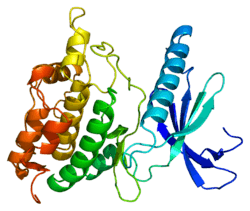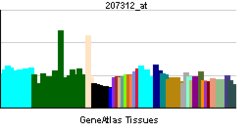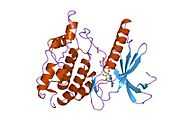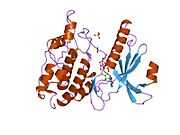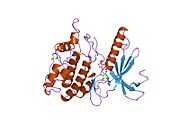PHKG1
Phosphorylase b kinase gamma catalytic chain, skeletal muscle isoform is an enzyme that in humans is encoded by the PHKG1 gene.[1][2]
This gene is a member of the Ser/Thr protein kinase family and encodes a protein with one protein kinase domain and two calmodulin-binding domains. This protein is the catalytic member of a 16 subunit protein kinase complex which contains equimolar ratios of 4 subunit types. The complex is a crucial glycogenolytic regulatory enzyme. This gene has two pseudogenes at chromosome 7q11.21 and one at chromosome 11p11.12.[2]
References
Further reading
- Jones TA; da Cruz e Silva EF; Spurr NK et al. (1990). "Localisation of the gene encoding the catalytic gamma subunit of phosphorylase kinase to human chromosome bands 7p12-q21". Biochim. Biophys. Acta 1048 (1): 24–9. doi:10.1016/0167-4781(90)90017-V. PMID 2297530.
- Harris WR; Malencik DA; Johnson CM et al. (1990). "Purification and characterization of catalytic fragments of phosphorylase kinase gamma subunit missing a calmodulin-binding domain". J. Biol. Chem. 265 (20): 11740–5. PMID 2365696.
- Dasgupta M, Honeycutt T, Blumenthal DK (1989). "The gamma-subunit of skeletal muscle phosphorylase kinase contains two noncontiguous domains that act in concert to bind calmodulin". J. Biol. Chem. 264 (29): 17156–63. PMID 2507540.
- Drewes G; Trinczek B; Illenberger S et al. (1995). "Microtubule-associated protein/microtubule affinity-regulating kinase (p110mark). A novel protein kinase that regulates tau-microtubule interactions and dynamic instability by phosphorylation at the Alzheimer-specific site serine 262". J. Biol. Chem. 270 (13): 7679–88. doi:10.1074/jbc.270.13.7679. PMID 7706316.
- Wehner M, Clemens PR, Engel AG, Kilimann MW (1995). "Human muscle glycogenosis due to phosphorylase kinase deficiency associated with a nonsense mutation in the muscle isoform of the alpha subunit". Hum. Mol. Genet. 3 (11): 1983–7. doi:10.1093/hmg/3.11.1983. PMID 7874115.
- Yuan CJ, Huang CY, Graves DJ (1994). "Oxidation and site-directed mutagenesis of the sulfhydryl groups of a truncated gamma catalytic subunit of phosphorylase kinase. Functional and structural effects". J. Biol. Chem. 269 (39): 24367–73. PMID 7929096.
- Malencik DA, Zhao Z, Anderson SR (1994). "Preparation and functional characterization of a catalytically active fragment of phosphorylase kinase". Mol. Cell. Biochem. 127-128: 31–43. doi:10.1007/BF01076755. PMID 7935360.
- Steiner RF, Juminaga D, Albaugh S, Washington H (1996). "A comparison of the properties of the binary and ternary complexes formed by calmodulin and troponin C with two regulatory peptides of phosphorylase kinase". Biophys. Chem. 59 (3): 277–88. doi:10.1016/0301-4622(95)00125-5. PMID 8672716.
- Paudel HK (1997). "The regulatory Ser262 of microtubule-associated protein tau is phosphorylated by phosphorylase kinase". J. Biol. Chem. 272 (3): 1777–85. doi:10.1074/jbc.272.3.1777. PMID 8999860.
- Lowe ED; Noble ME; Skamnaki VT et al. (1998). "The crystal structure of a phosphorylase kinase peptide substrate complex: kinase substrate recognition". EMBO J. 16 (22): 6646–58. doi:10.1093/emboj/16.22.6646. PMC 1170269. PMID 9362479.
- Sengupta A; Kabat J; Novak M et al. (1998). "Phosphorylation of tau at both Thr 231 and Ser 262 is required for maximal inhibition of its binding to microtubules". Arch. Biochem. Biophys. 357 (2): 299–309. doi:10.1006/abbi.1998.0813. PMID 9735171.
- Wang JZ; Wu Q; Smith A et al. (1998). "Tau is phosphorylated by GSK-3 at several sites found in Alzheimer disease and its biological activity markedly inhibited only after it is prephosphorylated by A-kinase". FEBS Lett. 436 (1): 28–34. doi:10.1016/S0014-5793(98)01090-4. PMID 9771888.
- Hanger DP; Betts JC; Loviny TL et al. (1998). "New phosphorylation sites identified in hyperphosphorylated tau (paired helical filament-tau) from Alzheimer's disease brain using nanoelectrospray mass spectrometry". J. Neurochem. 71 (6): 2465–76. doi:10.1046/j.1471-4159.1998.71062465.x. PMID 9832145.
- Schneider A; Biernat J; von Bergen M et al. (1999). "Phosphorylation that detaches tau protein from microtubules (Ser262, Ser214) also protects it against aggregation into Alzheimer paired helical filaments". Biochemistry 38 (12): 3549–58. doi:10.1021/bi981874p. PMID 10090741.
- Reynolds CH; Betts JC; Blackstock WP et al. (2000). "Phosphorylation sites on tau identified by nanoelectrospray mass spectrometry: differences in vitro between the mitogen-activated protein kinases ERK2, c-Jun N-terminal kinase and P38, and glycogen synthase kinase-3beta". J. Neurochem. 74 (4): 1587–95. doi:10.1046/j.1471-4159.2000.0741587.x. PMID 10737616.
- Liu F, Iqbal K, Grundke-Iqbal I, Gong CX (2002). "Involvement of aberrant glycosylation in phosphorylation of tau by cdk5 and GSK-3beta". FEBS Lett. 530 (1–3): 209–14. doi:10.1016/S0014-5793(02)03487-7. PMID 12387894.
- Strausberg RL; Feingold EA; Grouse LH et al. (2003). "Generation and initial analysis of more than 15,000 full-length human and mouse cDNA sequences". Proc. Natl. Acad. Sci. U.S.A. 99 (26): 16899–903. doi:10.1073/pnas.242603899. PMC 139241. PMID 12477932.
- Gevaert K; Goethals M; Martens L et al. (2004). "Exploring proteomes and analyzing protein processing by mass spectrometric identification of sorted N-terminal peptides". Nat. Biotechnol. 21 (5): 566–9. doi:10.1038/nbt810. PMID 12665801.
- Burwinkel B; Hu B; Schroers A et al. (2004). "Muscle glycogenosis with low phosphorylase kinase activity: mutations in PHKA1, PHKG1 or six other candidate genes explain only a minority of cases". Eur. J. Hum. Genet. 11 (7): 516–26. doi:10.1038/sj.ejhg.5200996. PMID 12825073.
PDB gallery |
|---|
| | 1phk: TWO STRUCTURES OF THE CATALYTIC DOMAIN OF PHOSPHORYLASE, KINASE: AN ACTIVE PROTEIN KINASE COMPLEXED WITH NUCLEOTIDE, SUBSTRATE-ANALOGUE AND PRODUCT |
| 1ql6: THE CATALYTIC MECHANISM OF PHOSPHORYLASE KINASE PROBED BY MUTATIONAL STUDIES |
| 2phk: THE CRYSTAL STRUCTURE OF A PHOSPHORYLASE KINASE PEPTIDE SUBSTRATE COMPLEX: KINASE SUBSTRATE RECOGNITION |
|
|
|
|
|---|
| | | | | | |
- Biochemistry overview
- Enzymes overview
- By EC number: 1.1
- 2
- 3
- 4
- 5
- 6
- 7
- 8
- 10
- 11
- 13
- 14
- 15-18
- 2.1
- 3.1
- 4.1
- 5.1
- 6.1-3
|
|
|
|
